Durango gets racier with SRT 6.4 Hemi
Filed under: Weekly test drives, Autos
By John Gilbert
Memorial Day weekend is celebrated by many as the ultimate race weekend, mainly because of the Indianapolis 500. Fittingly, then, our subject during Indy week is a vehicle that not only embraces the American drivers’ love of speed with the American family’s current love of SUVs
We’re talking the Dodge Durango SRT 392, and the test vehicle came in a gleaming white paint exterior, called, cleverly enough, “White Knuckle,” a clearcoat finish that makes its point: Drive this beast, but be ready for lightning quick power requiring maximum driver attention.
If this all seems familiar, it might be because loyal readers of New Car Picks may recall seeing an all-white hot-rod Dodge Durango, just a few months ago. It was the Durango GT, which came with almost all the visual tricks of the SRT, and with a properly spunky 3.6-liter V6 and an option available up to the 5.7-liter Hemi V8.
But it is time to give the Durango SRT 392 its moment in the sun, partly because of the tie-in with Race Weekend, and because the SRT 392 could leave all other Durangos in the weeds. This is more like a Dodge Charger SRT with three rows of seats and a bit more road clearance. And it is just as hot as the car-version Charger or Challenger SRT, because it has the same powertrain.
The SRT — for street, racing technology — gang hangs out behind the scenes at Dodge, thinking up ingenious ways to get more power out of its pride-and-joy Hemi V8 engines. The “392” is the monster engine, a 6.4-liter V8 fastened to an 8-speed heavy-duty transmission and steering wheel paddles, just in case the highly efficient transmission doesn’t up- or downshift quickly enough.
Trust me on this: Everything the Durango SRT 392 does it does swiftly enough for any normal performance-driving zealot. With all the firming-up and strengthening of the powertrain and suspension, the SRT 392 sticker price was $75,550. That’s a healthy leap from the more basic models’ range of mid-$30,000 to $60,000, but those who select it are not interested in moderation from a vehicle or its drivetrain or its image. And yet, while the more basic Durango won’t do what the sizzling SRT will do, the SRT 392 will easily settle in and do what a family hauler will do. Read more
Titan a pickup powerhouse before and after Midnight
Filed under: Weekly test drives, Autos
By John Gilbert
If you’re into large pickup trucks, what is your favorite feature?
Is it the Cord F150‘s low-cut leading edge of the side window design that greatly enhances side vision, or its pull out and drop down little stepladder off the rear of the Ford F150 bed, with its neat little pull-up helping pole? Or Chevy’s little slotted grooves in the outside rear corners of the rear bumper to provide step-up access to the bed? Maybe it’s the soft-touch tailgate on the Toyota Tundra, or Ram’s wider bed sides, which open from the top and can store virtually anything. The Honda Ridgeline has its entire bed made out of the composite material you needn’t buy as a bedliner, with a deep, watertight trunk cut into it. Or Nissan’s own clever slotted strips on either side and the front edge of the Titan’s bed, allowing infinite anchoring locations for sliding tie-down cleats.
How about “all of the above?”
Nissan didn’t quite corral all the top features but did incorporate its version of most of them in the 2018 Midnight Edition of the Titan. The Midnight Edition package costs $1,250, and boosts the total of the Titan to $54,775. That is not outrageously steep these days, and I also found that our overall combined fuel economy was 18.1, which also was acceptable, based on where we’ve come in the large V8-power truck biz.
Competition has driven the manufacturers to build extremely competitive pickups, so whatever you choose you know you’ll be getting great power output, heavy-duty towing and hauling capability, not much fuel economy, but interior accommodations that rival fine luxury sedans. So maybe the little extra touches can sway an undecided buyer.
Nissan has shamelessly broken down all the competitive barriers in building the 2018 Titan Midnight Edition, catching many by surprise, because the Titan had been left out of a lot of comparisons because there really wasn’t anything new on the truck. Nissan, however, had accomplished all the engineering and design stuff it felt was required, so it turned to cosmetic touches to set off a new fleet of special-edition vehicles for its cars and SUVs, and the Midnight Edition gives the same striking appearance benefit to the new Titan.
My test-drive Titan SL Midnight Edition came in a glossy black, which was more than just black when you got close enough to see the sun’s reflection reveal an amazing mixture of colorful highlights under the surface. The trick is to put black-on-black touches to every trim item, including the grille, the 20-inch alloy wheels, to the large Titan logo on the doors, and to every emblem all around.
It seems somewhat surprising that a company that has made its tremendous success on pragmatic but solid engineering and design would stoop to cosmetics, and, of course, it would be a mistake to accuse the Titan of making only cosmetic touches to create the Midnight Edition. The company has reached technical highs with things like its new variable compression ratio, even though it already has attained a high level of technology for its cars and trucks. Read more
Pacifica now offers electrifying performance
Filed under: Weekly test drives, Autos
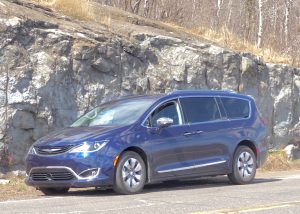
New Pacifica Hybrid Limited combines 3.6-liter V6 with electric hybrid power for smooth operation and high fuel economy.
Road-testing different vehicles every week can be similar to playing a real-life scene in “The Three Bears.” Open the door of a big pickup or large SUV, and you might say, “This is too high” as you high-jump aboard. Open the door of a normal size car the next week and you might say, “This is too low,” as you duck your head and drop down into the seat. And catch one of the dozens of new compact crossover SUVs, and be ready to adjust to either climbing up a lot or a little.
Then the 2018 Chrysler Pacifica Hybrid Limited shows up. You open the door, mentally prepared to climb up, then realizing you don’t need to, so you anticipate dropping down, but no. You simply step in and you are aboard.
“This,” says everyone from Papa Bear to Mama Bear to Baby Bear, “is just right.”
It wouldn’t seem so startling, except for all the variations that require ducking heads or hand-grip helpers to climb up or down. Indeed, we have almost caused minivans to skip out of our consciousness, and we shouldn’t.
My wife, Joan, and I took some good friends out for $1 Taco Night at Gronk’s in Superior, Wis., and we heard a number of comments, mostly of surprise. “There’s a lot of room in here.” Or, “Look at the cordless headphones.” Or, “There’s a lot of room in the third row, too.”
And that was before they had noticed what Joan and I caught almost immediately: The Pacifica Hybrid
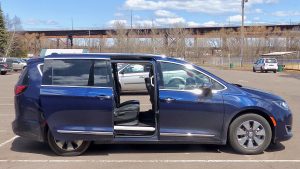
Side doors that open by key fob open the Pacifica to comfortable seating for five behind the front buckets.
Limited rides with amazing smoothness, and corners and even swerves without leaning, without losing its poise, and without anything approaching concern. It goes where you point it, and wherever the front end goes, the rest follows willingly along.
Chrysler, under Fiat fiefdom, made the switch a year ago, ending the long and highly successful run of the Dodge Caravan, and sister ship Plymouth-then-Chrysler Voyager, replacing them with an entirely new vehicle in the Pacifica. It was designed as a people hauler, as are all minivans, but this idea was to make it a stylish, contemporary family hauler that might someday elevate owning a minivan back to its once-exalted status.
You know the story. Station wagons gave way to minivans, and one day somebody woke up and decided minivans were “mom-mobiles,” good for hauling kids to soccer games and practices — or hockey, if you’re a Minnesotan — but outmoded for going to real events where a luxury sedan or SUV was the order of the day.
Minivans have soldiered on, and after the Pacifica made its worthy bid, and Honda followed with a much improved Odyssey, the realization hit those of us who test and compare different vehicles to realize that despite the scorn, minivans are still the most efficient, comfortable and economical way to haul families or, yes, soccer or hockey players, anywhere.
For 2018, there isn’t much change in the Pacifica, except the promised hybrid model is up and running, and it makes the Pacifica Hybrid the most fuel-efficient minivan in the industry.
The timing of my test week was interesting, because a “normal” Pacifica Limited was scheduled, but the week before it came, the scheduled vehicle had to be whisked away and sent elsewhere, and the substitute was the Pacifica Hybrid, also in top-end Limited livery. That meant I would have the unusual opportunity to drive both versions, back to back, for comparison purposes.
Also, this was not “just” a hybrid, although that’s big news on its own. This one is a plug-in hybrid, which has a neat little trap door on the front left flank, with a serious, industrial-strength outlet inside. Open the rear hatch and you will see a couple of small doors on the inner walls. On the lower left, you find a coiled cable with a serious-looking plug.
Now, California and the West Coast, and places on the East Coast are way ahead of Duluth, Minnesota, when it comes to electric car and even hybrid sophistication, but I was surprised and impressed recently when we went for a walk along that part of the Lake Walk that survived the late-winter battering from Lake Superior waves that a storm sent crashing out of its rather spacious basin. We walked for a few blocks, but the wind whistling off the big lake made our walk more of a challenge than we were looking for, so we turned inland and walked over toward 1st Avenue East. As we got there, we noticed three rows of parking with odd signs and devices. They are charging stations.
Electric car and plug-in hybrid charging stations in Duluth, Minnesota? Are you kidding me? Great!
Typical hybrids, you realize, have high-output but diminutive electric motors that can supplement a small engine’s power and even replace it for a few miles of moderate use, then normal driving lets the gas engine recharge the battery pack for further hybrid-electric help. Electric cars, on the other hand, don’t have any gas engine to recharge, and must be plugged in.
Plug-in hybrids are, to me, the best available compromise for everyday people. You don’t have the feeling of latent panic wondering if your electric car is going to run out of stored electricity, and you also don’t have to wonder how much of a charge your normal hybrid has executed. You can do a shorter plug-in at a charge site, and get your electricity fully loaded.
The Pacifica is the first minivan to have such a feature. It comes with a 3.6-liter Pentastar V6 in the normal Limited, which has a healthy 287 horsepower and 262 foot-pounds of torque, driving the front wheels. The battery pack and hybrid paraphernalia weigh a little, and cause the V6 to be tuned much differently, but then it combines to provide a total of 260 horsepower that moves the Pacifica with smooth force.
Despite what the numbers hint, the Hybrid Pacifica combines its two power sources in a manner that feels significanly quicker and faster than the normal one.
The other thing hybrids do along with coordinating and supplementing power from the gas engine is they can allow the vehicle to operate on electric power only. You don’t get much distance out of electric-only driving. Maybe 10 miles, before you’ll need to coast and brake and recharge the system internally. But with the plug-in charge filling the eletric capacity, you can go a reported 35 miles on electric power only.
To do that, you’d want to push the start button, and don’t think it failed you. It will be silent, but will notify you that it’s ready. Put the 9-speed transmission in gear and feather the gas, and off you go. You don’t want to stand on the gas, just creep away and you could make it to work and all the way home without exhausting the electric charge.
Stepping on it hard, to accelerate swiftly or to climb a steep hill, will cause the electric motor to hustle to help the gas engine and provide surprisingly strong force. It also will drain the electric juice long before that 35-mile range.
But it is fun to give it a little “gas” for brief moments now and then, just to surprise yourself with how swift the Pacifica Hybrid is. When adequately charged, you get smooth and seamless power that fits the Pacifica so well.
As gasoline rises inexorably up, up and away, you also can appreciate the fuel economy. The Limited non-hybrid showed us mid-20s for fuel economy, which isn’t bad. The hybrid, however, stayed mostly above 30 mpg, and that was without plugging in but trusting the normal hybrid system to do its charging.
The EPA estimates show the Pacifica Limited at 29 city and 28 highway, while the Pacifica Hybrid Limited shows 32 combined city-highway mpg, and a whopping 84 miles per gallon with the fully-charged hybrid system for combined city-highway driving, and plugging in for a 2-hour high-potency charge provides the top numbers.
Both vehicles came loaded with options, including all the safety stuff, a full-length panoramic sunroof, adaptive cruise, lane-departure warning, autostart, Apple CarPlay and Google Android capable, park assist, and both with Chrysler’s creative and imaginative power rear seat flip, hide, fold and disappear, plus power sliding side doors and both with opening side windows(!).
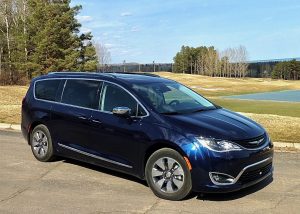
SUVs are all the rage, but top-level minivans like the Pacifica remain the best family-friendly way for feature-filled travel. .
The Hybrid Limited has a base price of $44,995 and an as-tested sticker of $48,580; the non-hybrid Limited starts at $43,695 and as-tested $49,665. Amazing, but the non-hybrid is a thousand more than the hybrid.
The hybrid model was Jazz Blue, and the non-hybrid was Velvet Red, both pearl-coat paint jobs. That made it easier to tell the difference after we had swapped one for the other.
And our friends, who own SUVs, trucks, and cars, joined our surprised impression after a couple of stops and reloads. “You just step into this, with no climbing,” they said.
Downsizing leads GMC across new Terrain
Filed under: Weekly test drives, Autos
By John Gilbert
It has always seemed as though vehicles with “GMC” logos on their grilles have gotten the short end of the promotional emphasis from General Motors, which seems to emphasize Chevrolet on about a 50-to-1 ratio in their advertising. But when you start evaluating the 2018 models, those GMC models are proving capable of standing by themselves.
It’s certainly a lot simpler to promote a big pickup truck, the Sierra, and a midsize pickup, the Canyon, and then line up your three GMC SUVs: the giant Yukon, the midsize Acadia, and the Terrain. The Yukon, of course, runs and is equipped parallel to Chevy’s Suburban and Tahoe, while the Acadia is paralleled by the Chevy Traverse.
The Terrain, meanwhile, has been made more compact and runs alongside Chevy’s Equinox. They are more compact than the midsizers, but that gives them a couple of very large advantages. For one, they are lighter and feel quicker than their more ponderous brethren farther up the size scale, and second, they don’t need the giant 6.2-liter V8 or even the 3.6-liter V6 to get around with quick agility in virtually every circumstance.
But it’s right about there that GM has allowed a split of the otherwise twin-running vehicles. True, they are still competitors for each other, but you can get the Equinox for somewhere between $24,500 and $35,000, and it has been entirely redone for 2018 and looks better than it ever has. The GMC Terrain also has been entirely redesigned, and its price ranges from a base $26,000 to a smidge over $40,000. The difference may be close to imperceptible, but I figure it goes for a few more luxury touches, and more sound-deadening in the GMC, which stands about one rung higher on the stepladder of GM SUVs. The Terrain seemed quieter than the Equinox I recently had driven, but that could be sound-deadening, or even a difference in tires.
I enjoyed my week-long test drive with the Terrain, which came at a time when I was required to make a couple runs from Duluth to Saint Paul for a hockey tournament. Any vehicle could breeze through that 400-mile round trip without breathing hard, but this particular week was one of those when Spring was engaged in mortal combat with Winter, and we were as likely to see sunshine and blue skies, or grey clouds and a snowstorm. Or maybe both, in the same day.
So having the GMC Terrain with its all-wheel drive was a nice comforting thought, knowing I wouldn’t get back home until 1 a.m. or so. Curiously, the Terrain’s all-wheel-drive system can be controlled by a knob on the console, rather than being the trendy automatic system so popular these days. Personally, I prefer having the right to make that adjustment myself, because you can improve fuel economy by a couple mpg-s if you are in front-wheel drive. I did, however, make sure to remind my wife, Joan, who is an excellent driver but needed to know that if you’re headed for a snow-covered hillside or it starts snowing, make sure to click into AWD.
The Terrain (and the Equinox) actually are smaller than they used to be, another refreshing twist by GM, which tended to always go bigger when given the option. With the runaway popularity of the SUV segment, GM is maneuvering to make sure they are competing in all the niches.
By making it smaller, the GMC Terrain has a base engine that measures only 1.5 liters, with a turbo bringing it up to adequate. My test vehicle had the optional 2.0-liter 4, also turbocharged, with 252 horsepower and 260 foot-pounds of torque. That’s more torque than the newly available 1.6-liter tiurbo-diesel by 10.
That made an interesting aside for my test-driving. The comfort and the neat driving and occupant features were all duly noted, and the numerous safety stuff, including a larger 8-inch touchscreen at the top of the center stack, and a new 360-degree camera that gives a top-down view of anything and everything around your Terrain. Then there’s the center console, cavernous in its capacity. It also has lane-keep assist, which some critics hate, but merely keeps you more advised on how you’re driving.
But the small engine made me always aware of how efficiently I could take off when pulling onto a freeway or highway, and it never faltered. That left the other key element to me, which was fuel economy.
The turbo adds power, and the 9-speed automatic worked well, so I had no trouble holding it at freeway maximums of 70 or so. I also anticipated that a long drive with the cruise at 70 would assure me of very strong fuel economy. I was wrong. I averaged between 24.8 and 25 miles per gallon, highway or city, AWD or FWD.
Now, we’re a spoiled lot here in the U.S., where as soon as gas prices drop, we all forget buying enery efficient cars and small SUVs and go after bigger, stronger, more powerful and less fuel-efficient vehicles. We’ve been riding a long crest of the gas price roller-coaster, and car dealers and salesmen will scoff at such nitpicking, but when gas prices start to rise, we know they can keep on a-rising.
Now the word comes that since our gas prices shot up by about a dime, then by another 15 cents, during the last two weeks of August, there’s a good chance they won’t be coming back. Summer, and a couple of major holidays, are on their way, so why would we expect fuel companies to drop their prices now?
In my usual grumbling about fuel economy, I always try to make the point that people really don’t seem to mind the rise and fall, once gas is less than $3 a gallon. But everyone who discusses it talks about the price of regular, without checking on the disparity between regular and premium. Used to be a nickel, then a dime, then it spread apart until now, when you might pay 30 or 50 cents a gallon more for premium.
If regular goes to $3.25, and you’re paying $3.70 a gallon because your car requires premium, or 91 octane, a tankful can be a pinch. It is a good reason to check when you’re buying a new vehicle and find out if it will run fine on regular. Over the course of five years, that could save you a lot of money.
Meanwhile, back to the advantages of the downsized Terrain, they come mostly in agility and the ease of handling in traffic, biut since GM is aiming the Terrain at top-selllng midsize SUVs like the Honda CR-V, Toyota RAV4, and Mazda CX-5 — all of which deliver over 30 mpg — then the Terrain should give me more than 25 mpg.
For those who don’t care about such trivia, the Terrain offers anybody who ever owned any GM SUV a lot to like. I think the new Equinox is much more attractive, and the Terrain is, as they say, industrial-strength handsome. The new grille might have started out trying to be a trapezoid, but with all four corners rounded elegantly, it makes a striking first impression. The silhouette also is dramatically more appealing, and my favorite view of the vehicle is the rear corner.
I didn’t realize that until the week following my test drive, when I was driving along on a short freeway stretch and spotted a very handsome car ahead and one lane over to my left. The way the side contours rose up slightly as they approach the rear, and almost meet the roofline caught my eye. I accelerated a bit so I could read the lettering on the rear: Terrain.
That says a lot. I spent so much of the week driving the Terrain I didn’t spend any of it outside it, where I could appreciate the redesign.


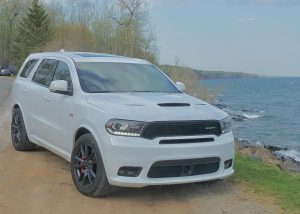
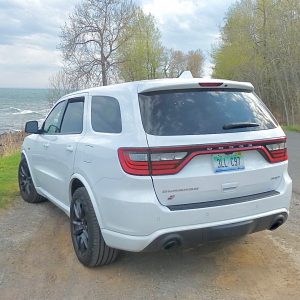
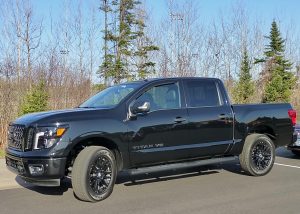
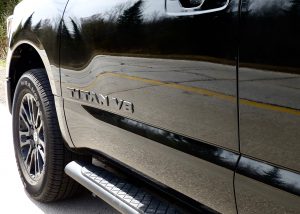
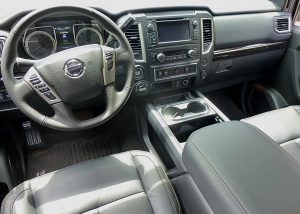
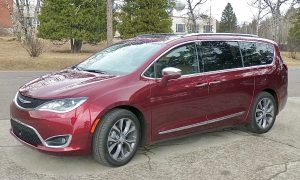
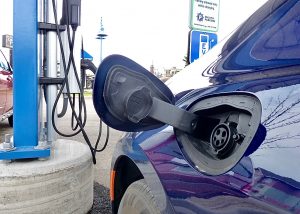
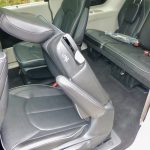
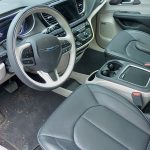
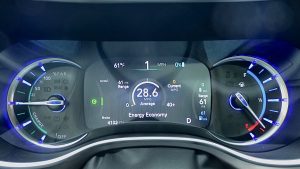
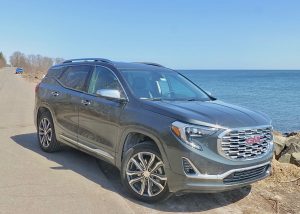
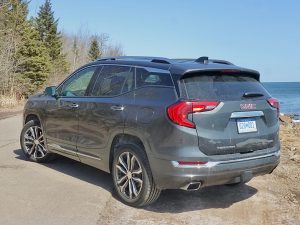
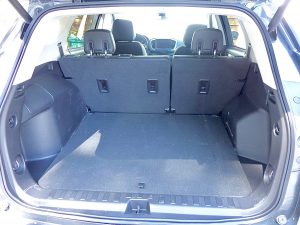
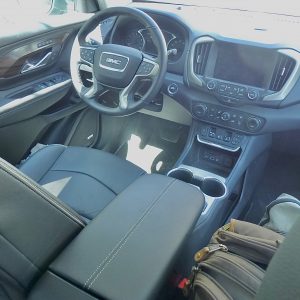
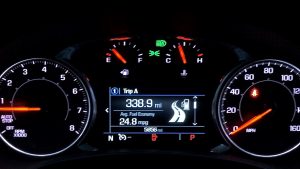
 John Gilbert is a lifetime Minnesotan and career journalist, specializing in cars and sports during and since spending 30 years at the Minneapolis Tribune, now the Star Tribune. More recently, he has continued translating the high-tech world of autos and sharing his passionate insights as a freelance writer/photographer/broadcaster. A member of the prestigious North American Car and Truck of the Year jury since 1993. John can be heard Monday-Friday from 9-11am on 610 KDAL(www.kdal610.com) on the "John Gilbert Show," and writes a column in the Duluth Reader.
John Gilbert is a lifetime Minnesotan and career journalist, specializing in cars and sports during and since spending 30 years at the Minneapolis Tribune, now the Star Tribune. More recently, he has continued translating the high-tech world of autos and sharing his passionate insights as a freelance writer/photographer/broadcaster. A member of the prestigious North American Car and Truck of the Year jury since 1993. John can be heard Monday-Friday from 9-11am on 610 KDAL(www.kdal610.com) on the "John Gilbert Show," and writes a column in the Duluth Reader.